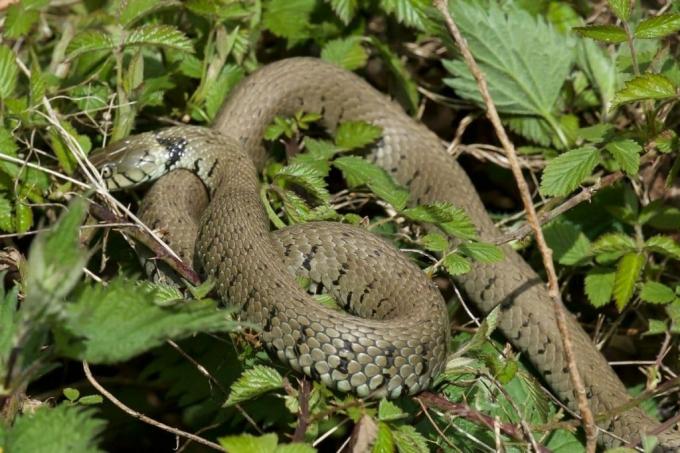
table of contents
- What snake can you meet in the garden?
- What can i do?
- Behave properly
- Evict and relocate
- frequently asked Questions
Encounters with a snake are rare - even more so in your own garden. That is precisely why you should know how to react correctly in order to avoid the unlikely event of a real confrontation.
In a nutshell
- Snakes avoid encounters with humans as much as possible
- the reptiles only attack when they feel threatened in no way
- loud stamping draws the animals' attention to you and enables them to escape
- you are not allowed to take active action against hitting because of species protection concerns
What snake can you meet in the garden?
Overall, it is very rare that you actually come across snakes in Germany. It is even less likely that this encounter actually takes place in the home garden. But once the time has come, most people don't know how to behave properly for that very reason. First and foremost, it is worth taking a quick look at what types of snakes you may even come across. Because with this knowledge, a large part of the horror can be avoided in advance. Overall, there is probably a good handful of species that are native to us and are present in sufficiently large numbers. Above all:

- Adder
- grass snake
- Other adders, e.g. B. Smooth snake and dice snake
Of these snakes, the adder is the only one that is poisonous. This means that the other animals are certainly able to defend themselves by biting them. However, this does not pose any real danger to humans.
Note: There are other types of snakes in Germany that are also poisonous. Like the aspic viper, for example, they can only be found regionally to a very limited extent, or they are represented in a generally minimal number of individuals.
What can i do?
Before we come to effective measures, let's take a look at what you can and cannot do from a legal point of view when you encounter a snake in your garden. The information should be sent in advance that all snake species native to Germany are placed under species protection due to their rarity and their ever-decreasing populations. For you, that means that you are allowed to take the animals
- not kill
- capture
- or disturb.

Behave properly
Instead, there are a few basic behaviors to keep in mind for face-to-face encounter:
- stay calm
- do not move or move slowly
- Avoid jerky, hectic movements
- slowly remove backwards
- step forcefully or stamp when walking
Why?
What do you want to achieve with this behavior? To understand this, you need to know the basic nature of a snake. Basically, these animals are initially deaf. This means that loud shouting, whistling or other noises have no effect. Instead, the animals orientate themselves by their smell and their eyesight. Rapid, jerky movements are interpreted by the animals as an attack, so that the likelihood of an attack as a counter-defense increases. If, on the other hand, you slowly move away from the meeting, the snake has the opportunity to also run away. The basic need of these living beings is, in general, to avoid meeting humans as far as possible. If you also step hard, the vibrations can be felt through the sensitive organs of the snakes. On the one hand, you draw attention to yourself and avoid a surprise. On the other hand, it becomes even more clear to the snake that you are moving away from the situation.

Evict and relocate
You are not allowed to attack snakes in the garden directly. However, there are other ways to get them out of your garden. Whether adder or adder, the animals will settle in your garden if they find a suitable shelter and sufficient food there. Both can be found here, for example:
- pile of leaves
- Compost heap
- Pile of wood
- Thick undergrowth
- Other protective structures with cavities and spaces
Because in these places the snake finds shelter as well as its prey, i.e. small mammals and insects. If you remove these livelihoods, the snakes will run away in the long run or they will not move in at all.
Note: Ultimately, snakes are clearly beneficial insects that keep the ecological balance stable. Unless eviction from the garden is absolutely necessary, you too will benefit from the presence of the Reptiles and should instead try to find possible shelters in less frequented areas of the garden embarrassed.
frequently asked Questions
In general, you should definitely consult a doctor. Because even non-poisonous animals can transmit tetanus pathogens under certain circumstances. Pay attention to the drawing of the snake skin and share it with the doctor. In this way it can be determined whether poison could possibly be involved. Vipers (also known as the adder) have a distinctive zigzag mark on their backs. In contrast, harmless snakes usually have only small spots.
No. Species protection also includes clutches and generally nests of the animals. Whoever destroys them is liable to prosecution. Instead, avoid possible nesting places such as piles of wood or piles of leaves from the start.
Despite their appearance, blindworms are not snakes. They belong to the lizards and are completely harmless even if they are quite large. If you encounter a sneak, move to the side and give it the opportunity to hide in the undergrowth or scrub.


